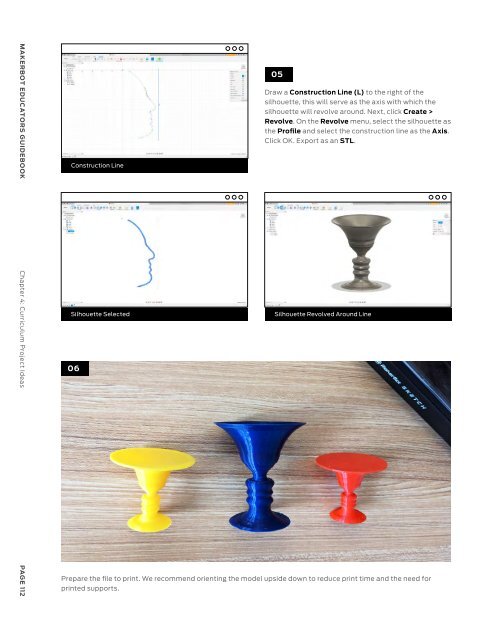MakerBot Educators Guidebook 3rd Edition
You also want an ePaper? Increase the reach of your titles
YUMPU automatically turns print PDFs into web optimized ePapers that Google loves.
MAKERBOT EDUCATORS GUIDEBOOK Chapter 4: Curriculum Project Ideas<br />
PAGE 112<br />
Draw a Construction Line (L) to the right of the<br />
silhouette, this will serve as the axis with which the<br />
silhouette will revolve around. Next, click Create ><br />
Revolve. On the Revolve menu, select the silhouette as<br />
the Profile and select the construction line as the Axis.<br />
Click OK. Export as an STL.<br />
Construction Line<br />
Silhouette Selected<br />
Silhouette Revolved Around Line<br />
06<br />
Prepare the file to print. We recommend orienting the model upside down to reduce print time and the need for<br />
printed supports.<br />
05<br />
EXPLORING MORE PROJECTS<br />
ROMAN SCULPTURE - LAOCOÖN<br />
AND HIS SONS<br />
Thing #: 2720417<br />
@icefox1983<br />
Students can select and print statues and structures<br />
inspired by the art of Ancient Greece & Rome. These<br />
prints can be used in a variety of ways - from studying<br />
art forms and architectural marvels, imagining<br />
how these statues looked painted and how they<br />
represented, making inferences about the time’s<br />
politics and environment, to observing how these<br />
statues and structures reflected the eras in which they<br />
were created.<br />
Licensed Under: CC BY 4.0<br />
GREAT PYRAMID OF GIZA<br />
Thing #: 296260<br />
@<strong>MakerBot</strong><br />
Give students the opportunity to hold the Great<br />
Pyramid in their hands and see how each block of stone<br />
makes up this famous structure - students can also<br />
look inside the pyramid to get a better idea of how the<br />
pyramid was used.<br />
Licensed Under: CC BY 4.0<br />
ROMAN AQUEDUCT<br />
Thing #: 3552200<br />
@Juest1147<br />
Using one of the many aqueduct prints found on<br />
Thingiverse, have students hypothesize what the<br />
structure was used for. Next, discuss methods of<br />
moving freshwater from a source to different locations<br />
in a city. With 3D printing, allow students to design<br />
and print their own aqueducts that can move water<br />
from one location to another.<br />
Licensed Under: CC BY-NC-SA 4.0<br />
MAKERBOT EDUCATORS GUIDEBOOK Chapter 4: Curriculum Project Ideas<br />
PAGE 113





